We traveled between Japan and Europe during the Covid pandemic
Japanese borders have stayed tightly closed during five months from the first wave of Coronavirus 🦠 (April to August included), but several long-awaited easing have come to be progressively implemented since early September.
One of them is the possibility for expatriates in Japan who exited the territory to be authorized to come back in the archipelago. It was a huge stumbling block for many foreign residents, who make their life in Japan but who had to temporarily travel abroad, for example in the event of a relative’s death.
Since September 1rst at last, they are free to come back to Japan, in the same way as Japanese citizens who were always permitted to do so. What triggered this article was one of Kanpai’s collaborators’ trip between Japan and France made at the end of September. After 6 months under Covid-19 limitations in Japan, where the outbreak seems efficiently tackled, he was eager to come back in France to reunite with family for a 3-weeks break. Unfortunately, it was also the moment when the second wave hit the largest cities in France.
The resumption of tourism in Japan was announced for a tentative April 2021. As a testimony of the current situation, we decided to give an account of our colleague’s surprising round trip from Japan to France.
Don't forget to subscribe to Kanpai's newsletter to stay up to date on Japan's borders reopening to international tourists:
👩🔬 Before departure: choosing a flight and PCR testing in Japan
We chose Emirates airlines for our travel between Osaka and Paris, mainly for budget reasons (as you may know, 2020 is a difficult year for those working in tourism industry).
PCR testing was not mandatory for direct flights, but Emirates required one to board the plane ✈️ as there was a stopover. The test must be performed at the earliest 96 hours before takeoff. Getting an appointment in Japan is easy, but it cost about ¥40,000 (~US$258.30), way more expensive than in France, where the ~70€ cost is supported by the welfare system.
To be as precise as possible, the PCR test can be free in Japan – when developing Covid symptoms – but in this case, the tested person cannot obtain the necessary certificate to travel.
The testing procedure is remarkable: in a small room, a seat is placed facing a widely opened window with a fan blowing at maximum strength in the back. In case of any sneeze or cough, every miasma is supposed to be expelled outdoor! The practitioner, clad in protective gear (gown, mask and face shield), thus stays behind the person to take the nasopharyngeal swab.
The result of the test is provided under 24 to 48 hours, and if it is negative, you are good to go!
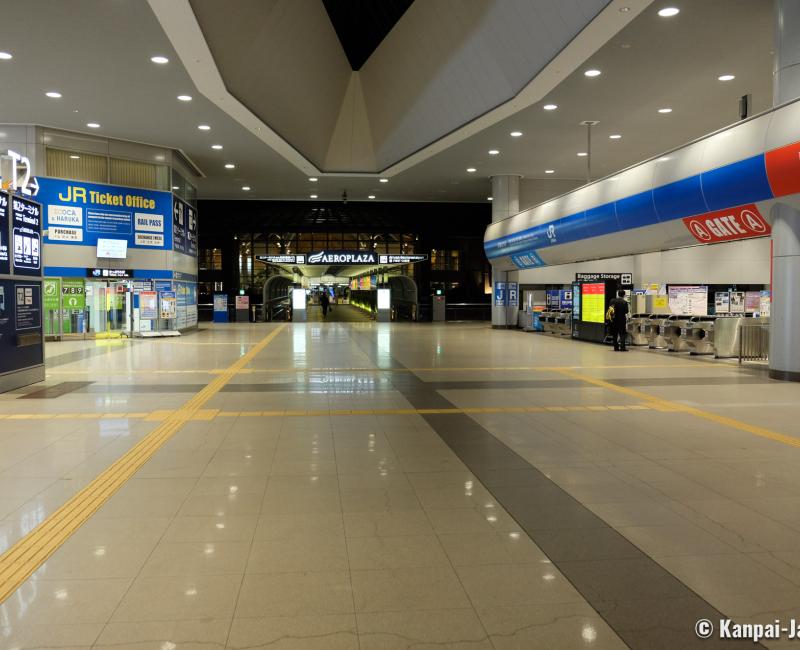
🛫 The departure day: in Kansai Airport
Kansai Airport in Osaka was almost totally empty, even in the departure hall. The only counter opened during our passage was Emirates’.
There was no waiting line for the check-in, but the process was nonetheless quite long due to a procedure requiring the ground crew to check many items for each passenger. There was no waiting line either at security check.
In the customs 🛂 area, 6 persons of the staff checked that passengers were holding the re-entry permission e-mail delivered by the Japanese Immigration Agency.
Then, the duty-free zone was totally empty! During a 20 minutes’ wait, the only persons we met were cleaning staff or stores’ employees. Besides, most of the shops were closed.
We were the only passengers in the shuttle. Everything was closed in the boarding hall, even the famous Family Mart konbini.
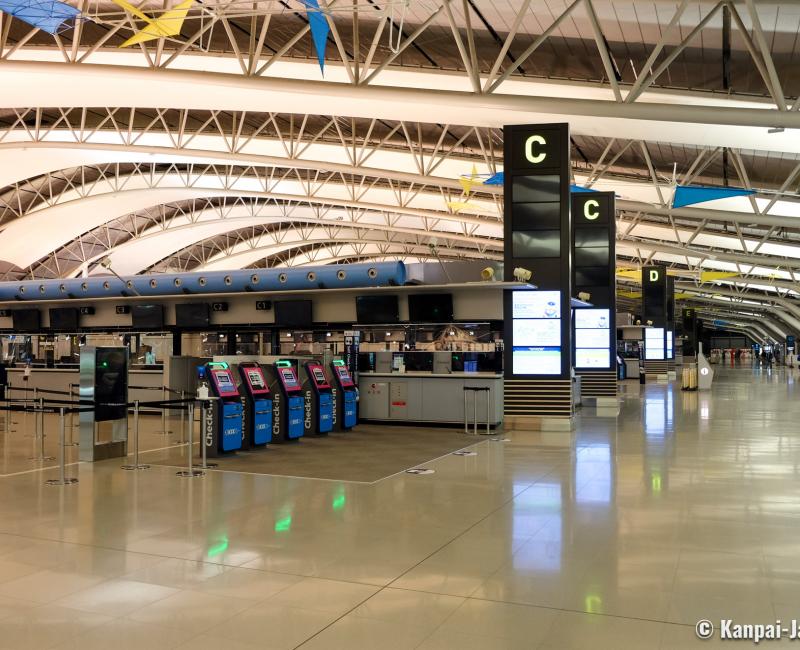
✈️ In the plane and during the stopover
We were about 30 passengers, for fifteen persons flight crew!
In the plane (a Boeing 777), we were placed according to social distancing rules, with a large distance between passengers and the interdiction to change seat. It was in fact a quite comfortable situation, with 7 seats per person, and as many blankets and pillows! It was thus possible to sleep comfortably, lying on the 4 central seats.
Was it related to Covid? The aperitif before the meal was not served.
We made a stopover in Dubai, where our negative PCR test was checked. We had to wear gloves (provided in the plane) to go through the security check.
The second flight (in an A380) was filled with a little more passengers: about fifty, which still allowed for a comfortable and less tiring trip. Except this time, we were asked to fill a form for contact tracing and possible case investigation.
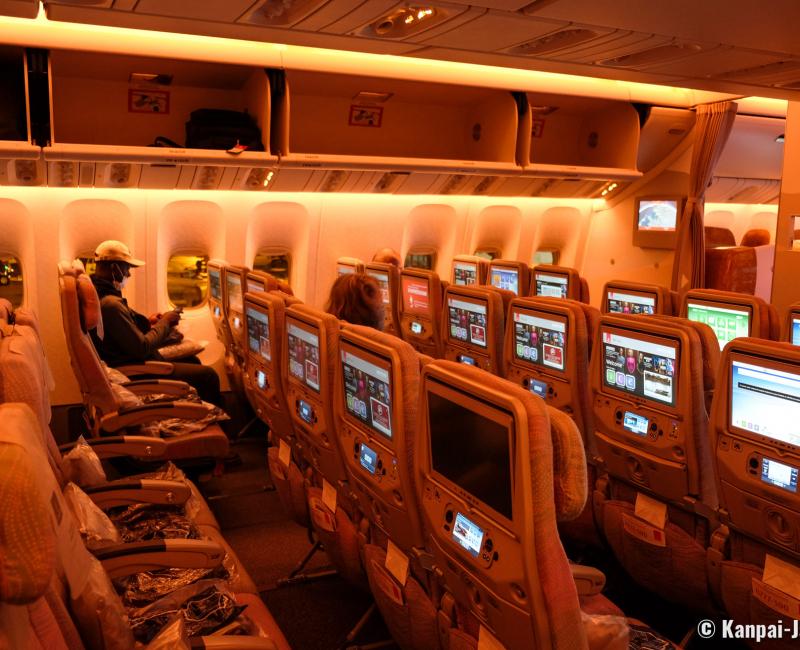
🇫🇷 Landing in France
Surprisingly, only our passport was controlled at the arrival in Charles de Gaulle Airport: French borders agents were not interested at all by the forms filled at our departure airport, nor by our PCR test!
It may be due to the fact that Japan was registered as a green country in the Schengen area’s list since July 1rst.
The French airport was as empty as its Japanese counterpart. Only Terminal 2 was operating, but almost all the lifts and doors remained closed. We were just asked our flight tickets to exit through the main doors.
We then fared through the usual airport maze to reach our transportation method.
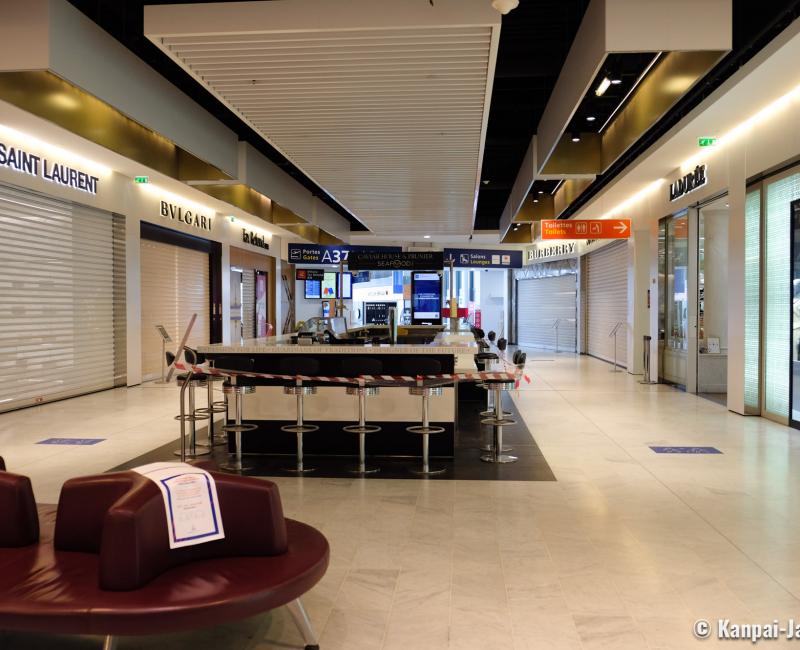
👃 The drudgery of PCR test in France
In Paris, and two weeks before returning to Japan, we began to investigate on how to get a PCR test in France before the flight back. However, at the end of September, as the second wave of Covid was steadily rising in Europe, all the hospitals and laboratories in Paris we have contacted by phone or through dedicated apps offered only:
- An appointment at best in a 3-weeks delay, thus too late for our flight;
- Results provided from 5 to 10 days after the test, which was incompatible with the 72 hours before takeoff requirement.
We thus started to search for smaller cities with less delay and an easy access on a one-day trip. The PCR test is free in France, even for non-residents, but it can nonetheless become costly depending on the constraints you have to take it!
Eventually, a friend used their connection with a nurse. However, due to specific circumstances, she could not perform the test herself but got an appointment for us in a laboratory that could comply with our quick result requirement. We could only solve the problem thanks to our connections.
Fortunately, since October 26, Parisian airports can perform rapid antigen testing, with a result in 30 minutes.
🛬 The flight back to Japan
To ensure a smooth boarding, we arrived in Paris airport 3 hours before takeoff. There was no waiting line for check-in, but the process itself was quite long, again to check all our documents:
- The negative PCR test, of course,
- The zairyu card (Japanese residence card),
- The permission e-mail for re-entry in Japan delivered by the Embassy,
- The re-entry form attached to the passport when leaving Japan.
The other procedures went by fast, as there were almost no travelers, and we thus arrived in the boarding zone more than 2 hours before departure. The duty-free zone was still quite empty, but there were visibly more passengers in the flight to Dubai than on our first flight (at least double).
We were not asked to wear gloves during the stopover. The boarding happened to be quite long as the staff checked every document and many passengers did not have their PCR test in the format required by immigration procedures.
In the flight Dubai > Osaka, we were 51 passengers, most of them being persons who were just delivered long-term visas: for students, workers, cultural activities, etc.
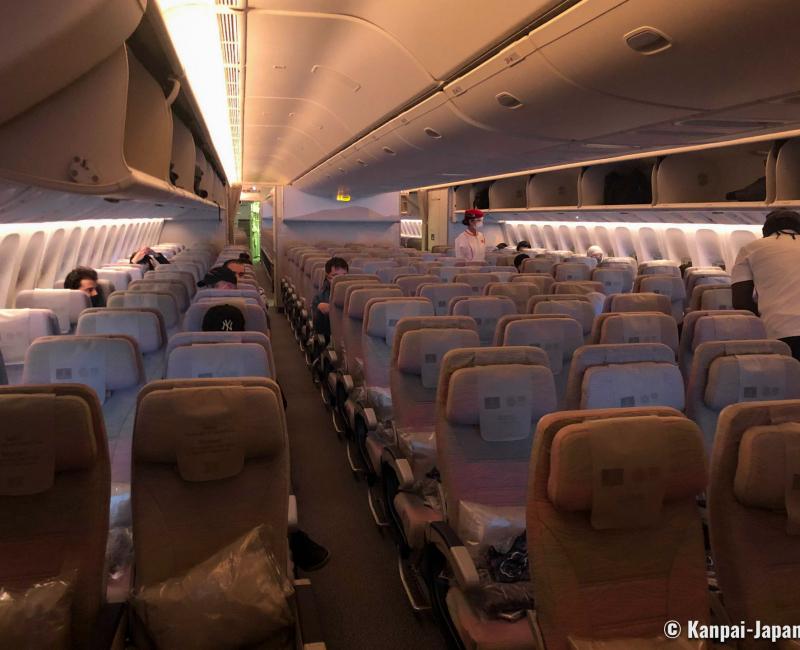
🇯🇵 At the landing airport in Japan
We waited about fifteen minutes in the plane after landing, while an inspector checked flight documents with the crew (that is what was announced in Japanese). Meanwhile, we were handed the road map (in English) for our next Covid test.
We disembarked and were asked to sit down on folding chairs to wait for the shuttle, and the staff checked that we were holding the 2 required documents… except that only one (the place of quarantine declaration) was given! We thus had to fill another form in a hurry to state where we came from and if we had any symptom.
We boarded the shuttle by small groups and once again were made to sit on folding chairs. Each person was handed an individual barcode and a swab tube for saliva testing. Our documents were checked, and we proceeded one after the other for the saliva test in a booth, with staff members making sure there was enough testing material in the tube.
We were then explained how to quarantine and asked our preferred contact method, either by phone, or by Line, the omnipresent social network in Japan. We were handed additional documents, to fill in even if we already declared the same information in previous forms.
We were then moved to another zone dedicated to our flight, to wait for our barcode number to be displayed on a screen, the signal to go collecting our test result:
- A "negative" sticker was placed on the barcode sheet,
- And a small red paper (a strange choice of color indeed) was given to confirm that we were tested negative.
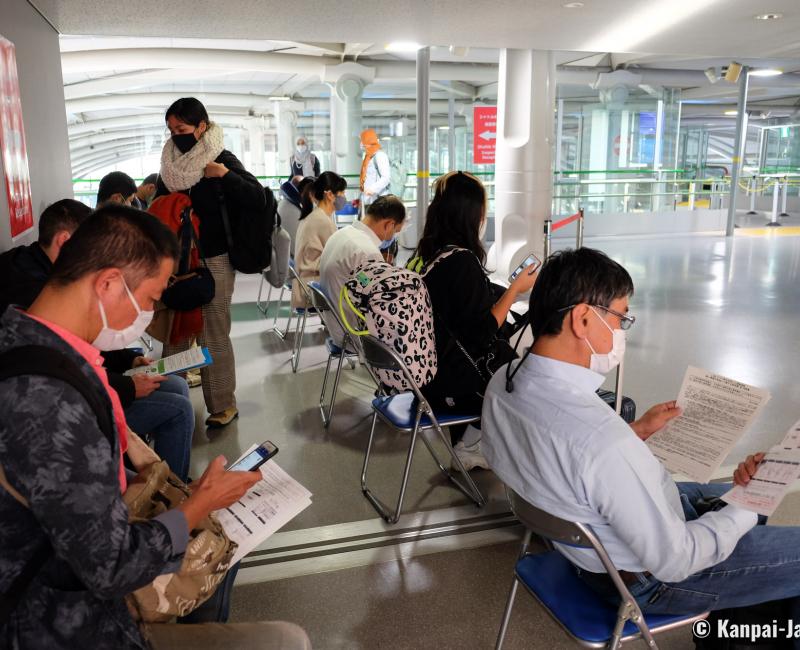
Then, in the immigration area, each passenger’s documents were meticulously verified. There was no doubt that we were back in Japan! It took 20 minutes to have our case thoroughly checked, including the PCR test taken in France, while we filled (again!) other papers regarding our health…We were made to sit again, before eventually being handed our passport stamped with the permission to enter Japanese territory.
Our baggage has naturally been waiting for us for a long time. The airport staff checked each luggage voucher and handed us the suitcase individually. We went through the customs area without being controlled. It took a total of 2 hours between the landing and the moment we exited the airport.
As it was forbidden to use public transportation and that "Corona-taxi" (taxis equipped especially for airports arrivals during the pandemic) costs are over-expensive, a friend came to collect us by car 🚙. Without any worry since we had 2 negative PCR tests over the last 3 days!
🕰 The quarantine in Japan
Let us remind that quarantine in Japan is for long-term residents. It does not apply to short term travelers such as businesspeople, nor to tourists starting from the beginning of 2021.
Every day at 10 a.m., we received a message on Line, with always the same 2 questions:
- Do you have fever (a temperature higher than 37,5°C / 99,5°F)? In Japan, the average body temperature is usually lower, around 36°C / 96,8°F.
- Do you have Covid symptoms: cough, pain in the throat, stuffy or runny nose, weariness, difficulty breathing…
If the message on Line was not answered by 2 p.m., we received a phone call.
According to the information provided, we were authorized to go out only if necessary (for example to shop for grocery) or in case of emergency, but always with a sanitary mask 😷 on the face, and never using public transportations or taxi.
The press tours planned for Kanpai have thus been scheduled more than 14 days after our return in Japan.
😶 Kanpai’s thoughts on this travel
In the same vein as our visit of Kyoto and Nara emptied from tourists in spring 🌸, the flight between Japan and Europe during Covid pandemic was somehow distressing. However, anti-Coronavirus hygiene measures were largely enforced, and we felt that we travelled safely.
It was a surrealistic as well as paradoxical experience to travel with more comfort than usual and on a different pace (except for the travel back). It is however difficult to enjoy this level of comfort when the global crisis so greatly impacted the world, and especially tourism and other related industries (aeronautics, travel agencies, etc.). We almost came to regret overcrowded airports!










